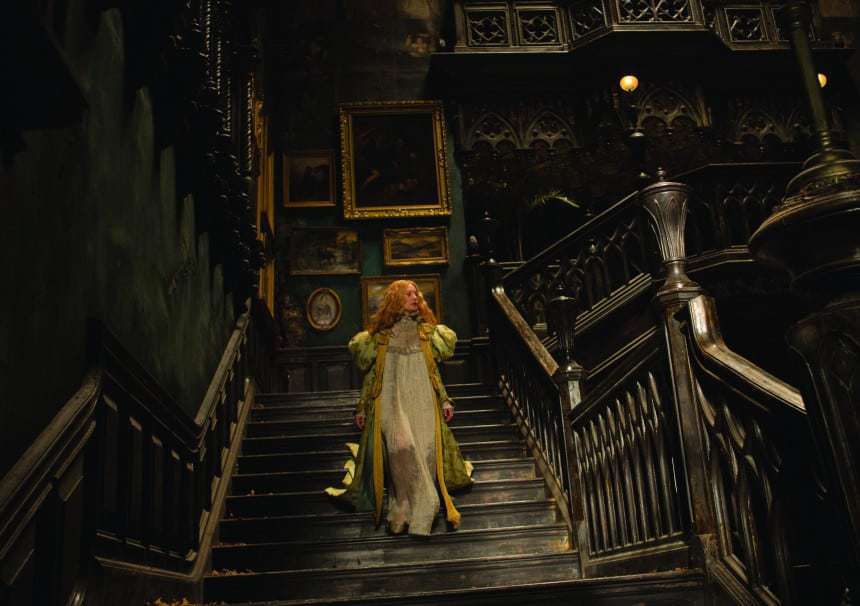Crimson Peak is a sensory feast rather than a character drama. In this, the film takes its cue from the mechanics of gothic literature, which is less about plot and more about atmosphere.

After a decade of torture porn, horror cinema is finally heading back to its roots: classic gothic fiction. Unlike grimy blockbusters about brutalized human bodies, gothic horror acts upon the mind by subverting the familiar and turning it into the grotesque: your home is out to get you; your husband is trying to poison you; and this family’s relationships are goddamn freaky. Audiences are leaving behind the ilk of Saw and Hostel to revisit classic tales like Frankenstein and H.P. Lovecraft — which are a welcome reprieve from the deluge of gore horror.
In this context, Guillermo Del Toro’s richly atmospheric film Crimson Peak is a fresh step toward the resurrection of old-school horror. Not only is it a sumptuous big-budget film starring Hollywood actors — it’s also one of the first original works of fiction staking its place in the current gothic revival.

Crimson Peak is a gothic horror film, and it revels in the conventions of the genre. Its plot encompasses themes that characterize gothic fiction: madness, darkness, the past, and the grotesque, often but not always coupled with the unearthly. When aspiring author Edith (Mia Wasikowska) was young, her mother’s ghost returned from the grave, and warned her to “Beware of Crimson Peak”. Years later, Edith meets Byronic Baronet Thomas Sharpe (Tom Hiddleston), an impoverished aristocrat peddling his new invention. She’s instantly seduced, despite his obvious fortune-hunting and hella shifty air. Thomas marries Edith and her sizeable fortune, and the couple join Sharpe’s chilly sister Lucille (Jessica Chastain) at their ancestral residence of Allerdale Hall — a.k.a. Crimson Peak.
Crimson Peak isn’t really a home, but a living, consuming entity that feels inescapable, even for the dead. It isn’t just a little bit ramshackle — there’s a giant hole in the ceiling of the entrance hall (what do they do when it rains?). Red clay oozes up from beneath the floorboards and stains the snow outside, so the house itself appears to be bleeding. Its inhabitants are just as unsettling. Thomas proves feverishly fixated on his machine rather than on his young wife; Lucille’s behaviour is unbalanced and she’s obsessed with her brother. Edith’s discomfort turns to terror as she is pursued by horrifyingly disfigured ghosts.“We could go anywhere!” Edith pleads with Thomas. But Lucille pitilessly reminds her, “You have nowhere else to go.”
[quote type = center]”Crimson Peak” is a sensory feast rather than a character drama[/quote]
Crimson Peak is a sensory feast rather than a character drama. In this, the film takes its cue from the mechanics of gothic literature, which is less about plot and more about atmosphere. Gothic imagery is always over the top, with themes literalized and cranked up to eleven. The film’s luxuriant costumes exemplify this extravagance. The innocent Edith has golden hair and wears billowing virginal white, whereas Lucille’s red satin gown calls to mind a freezing Elizabeth Bathory, ready to prey upon her sister-in-law. Our eyes linger on their rich textures and theatrical shapes.
The plot has a few screws loose, but this matches gothic progenitors like The Castle of Otranto — hardly a masterpiece of consistency. How does Edith’s dead mother know where her daughter might someday live? And why can’t she call it what everyone else does: Allerdale Hall? The film’s pacing judders, never quite finding a rhythm, and its shifts back and forth between Edith at Crimson Peak and her bland acquaintance Alan (Charlie Hunnan) in America do nothing to help the flow. By the time Crimson Peak shifts into dizzying overdrive near the end, even Hiddleston seems wearied by his millionth frantic protestation of love.
Del Toro’s original script is full of callbacks to familiar tales, as Crimson Peak looks backward to classic iterations of horror. I counted The Changeling (red ball and wheelchair); Lizzie Borden (took an axe, gave her mother forty whacks…); Rose Red; Flowers in the Attic; The Fall of the House of Usher; and the story of Bluebeard, a plotline evident from the trailer. Like Crimson Peak, these stories centre on family trauma and claustrophobic spaces where characters are threatened by their very surroundings. But this film owes most to Bram Stoker’s Dracula, particularly Stoker’s tonal juxtaposition of modern technologies and creaking tradition. As loving homage rather than modern reinterpretation, Crimson Peak advances an old horror tradition enjoying overdue resurrection.

